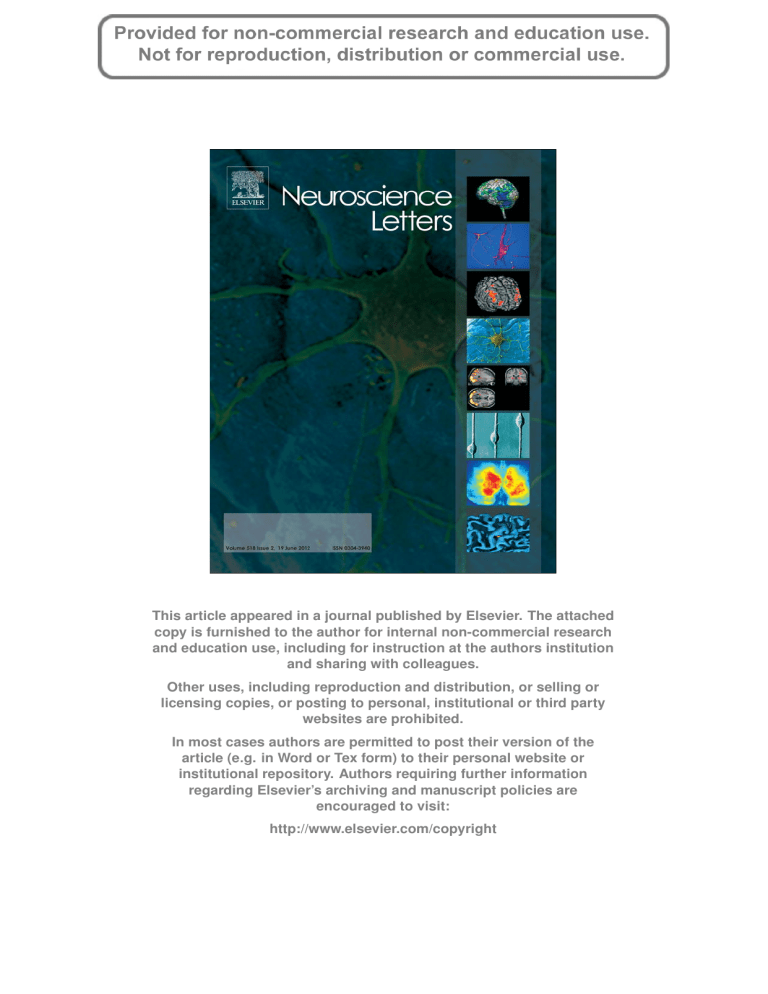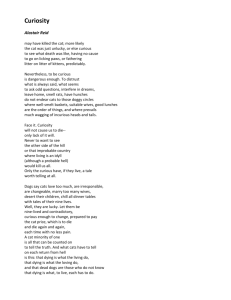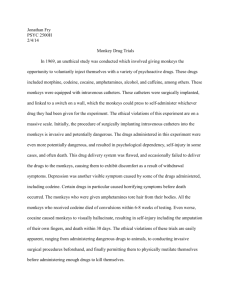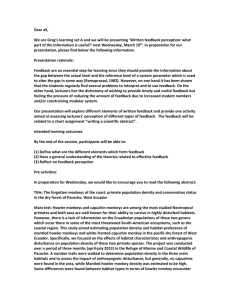
This article appeared in a journal published by Elsevier. The attached
copy is furnished to the author for internal non-commercial research
and education use, including for instruction at the authors institution
and sharing with colleagues.
Other uses, including reproduction and distribution, or selling or
licensing copies, or posting to personal, institutional or third party
websites are prohibited.
In most cases authors are permitted to post their version of the
article (e.g. in Word or Tex form) to their personal website or
institutional repository. Authors requiring further information
regarding Elsevier’s archiving and manuscript policies are
encouraged to visit:
http://www.elsevier.com/copyright
Author's personal copy
Neuroscience Letters 518 (2012) 172–175
Contents lists available at SciVerse ScienceDirect
Neuroscience Letters
journal homepage: www.elsevier.com/locate/neulet
Curious monkeys have increased gray matter density in the precuneus
Kimberley A. Phillips a,b,∗ , Francys Subiaul c , Chet C. Sherwood d
a
Department of Psychology, Trinity University, San Antonio, TX 78212, United States
Southwest National Primate Research Center, Texas Biomedical Research Institute, San Antonio, TX, United States
c
Department of Speech and Hearing Science, The George Washington University, Washington, DC 20052, United States
d
Department of Anthropology, Center for the Advanced Study of Hominid Paleobiology, The George Washington University, Washington, DC 20052, United States
b
h i g h l i g h t s
We examine the neural correlates of curiosity.
Curious monkeys had a greater density of gray matter in the precuneus.
The precuneus is associated with integrated tasks such as memory and self-awareness.
Monitoring self-awareness may play a role in cognitive processes mediating curiosity.
a r t i c l e
i n f o
Article history:
Received 14 January 2012
Received in revised form 11 April 2012
Accepted 1 May 2012
Keywords:
Curiosity
Exploratory behavior
Cebus
VBM
a b s t r a c t
Curiosity is a cornerstone of cognition that has the potential to lead to innovations and increase the
behavioral repertoire of individuals. A defining characteristic of curiosity is inquisitiveness directed
toward novel objects. Species differences in innovative behavior and inquisitiveness have been linked
to social complexity and neocortical size [18]. In this study, we observed behavioral actions among nine
socially reared and socially housed capuchin monkeys in response to an unfamiliar object, a paradigm
widely employed as a means to assess curiosity. K-means hierarchical clustering analysis of the behavioral responses revealed three monkeys engaged in significantly more exploratory behavior of the novel
object than other monkeys. Using voxel-based-morphometry analysis of MRIs obtained from these same
subjects, we demonstrated that the more curious monkeys had significantly greater gray matter density in the precuneus, a cortical region involved in highly integrated processes including memory and
self-awareness. These results linking variation in precuneus gray matter volume to exploratory behavior suggest that monitoring states of self-awareness may play a role in cognitive processes mediating
individual curiosity.
© 2012 Elsevier Ireland Ltd. All rights reserved.
1. Introduction
Curiosity is the desire to learn about what is unknown. Montgomery [15,16] postulated that human and animal behavior is
often motivated by such self-enrichment tendencies. His approachavoidance theory maintained that curiosity is a balance between
two motivations—the drive to explore and the fear resulting from
the novel situation. Berlyne [5] considered curiosity to be a motivational drive, and a prerequisite for exploratory behavior. The
motivation for curiosity is unique from other drives in that it is
aroused not by an internal state in the individual, but rather by
a novel external stimulus. This motivation is also satiated quickly
with continuous exposure to the stimulus.
∗ Corresponding author at: Department of Psychology, Trinity University, One
Trinity Place, San Antonio, TX 78212, United States. Tel.: +1 210 999 7102;
fax: +1 210 999 8386.
E-mail address: Kimberley.Phillips@Trinity.edu (K.A. Phillips).
0304-3940/$ – see front matter © 2012 Elsevier Ireland Ltd. All rights reserved.
http://dx.doi.org/10.1016/j.neulet.2012.05.004
Curiosity and exploratory behavior are intertwined and as such,
difficult to define independently; both terms are used to refer to
behavior that provides a gain in information about the environment.
The neurobiology underlying curiosity remains poorly understood. In humans, curiosity has been linked to functional
activation in the inferior frontal gyrus (Broca’s area) and
the caudate nucleus, associated with anticipated reward [13].
Dopaminergic receptors in the dentate gyrus are associated
with the generation of exploratory behavior in mice [20];
these receptors also play a role in learning and memory.
Here, we characterized behavioral responses among nine
socially reared and socially housed capuchin monkeys to a novel
object, a paradigm widely employed as a means to assess curiosity
[8,17,25]. Additionally, we obtained high-resolution T1-weighted
structural magnetic resonance images of the brain from these
same monkeys, to relate neuroanatomical differences to their
behavior.
Author's personal copy
K.A. Phillips et al. / Neuroscience Letters 518 (2012) 172–175
173
Fig. 1. Still images illustrating an individual monkey engaging in tactile exploration (a) and olfactory and visual exploration (b).
2. Materials and method
2.1. Subjects
Nine adult capuchin monkeys (Cebus apella) were used in
this study, including five males and four females ranging in age
from 5 to 23 years (M = 13.4 years, SD = 6.6 years). Subjects were
socially housed in enriched environments with perches, swings,
and fresh browse. The social composition of this group closely
resembled that of wild groups; furthermore, normative capuchin
social behavior–including grooming and playing—was regularly
displayed. New World Monkey Chow and water were available ad
libitum; fruit was provided once a day. This study was carried out in
strict accordance with the recommendations in the Guide for the
Care and Use of Laboratory Animals of the National Institutes of
Health and was approved by the Institutional Animal Care and Use
Committee, Hiram College, Hiram Ohio, USA.
2.2. Behavioral testing
All subjects were removed from the social group and tested
individually in a separate enclosure (1.5 m × 1.5 m × 2.4 m), without a human present. All were familiar with the enclosure from
participation in a prior experiment on prey capture behavior [10].
Monkeys remained in the enclosure for 5 min, where they had no
auditory or visual contact with other monkeys or humans. Behavioral responses were scored from video recordings made of the
testing session. The enclosure had a Plexiglas panel on the front
portion through which unobstructed visual access was provided.
Before a trial began, a brightly colored, novel object was hung on a
wall on the inside of the enclosure (Developlay Activity Center by
Tiny Love). This children’s toy has several objects that can be manipulated through pulling, pushing, turning, etc. Different textures,
sounds, and colors enhance the novelty and feedback responsiveness of the object. A perch was positioned beneath the object to
provide access to subjects.
A video camera was positioned on a tripod to provide an
unobstructed view of the perch and object. A trial began once a
subject was transferred into the testing enclosure. During trials, the
experimenter was not in the room and was no longer in visual
or auditory contact with the subject. The subject was allowed to
explore the novel object for 5 min. After 5 min the experimenter
returned to the room and turned off the video camera; the subject
was transferred out of the testing enclosure and returned to the
social group. Each subject received one trial.
2.3. Image acquisition
Structural MRIs of the brain were obtained from subjects separately from the behavioral testing session. In order to obtain the
noninvasive MRI images required for this study, the subject’s head
needed to be immobile during the scan. Therefore, the capuchins
were anesthetized for the procedure. Anesthesia was used only for
the purpose of restraint during collection of the brain images. Subjects remained anesthetized throughout the MRI procedure and
respiration rate, heart rate, and oxygen consumption were continually monitored by a veterinarian.
In vivo structural magnetic resonance scans were obtained for all
subjects on a Siemens 3.0 Tesla Scanner at the Neuroscience Imaging Center in Pittsburgh, PA. Subjects were initially immobilized by
ketamine (7 mg/kg) and meditomidine (0.06 mg/kg) injection and
subsequently anesthetized with propofol (250–350 g/kg/min).
Subjects were then placed into the scanner chamber and their
heads were fitted inside a 12 cm head coil. High-resolution
(isotropic 0.5 mm) T1-weighted 3D MPRAGE scans were acquired
(TR = 1500 ms, TE = 3.04 ms, no echo-train, number of signals
averaged = 3, matrix size = 256 × 256). Scan acquisition time was
approximately 50 min. After completing the MRI procedure subjects were allowed to recover from the effects of anesthesia before
return transport.
Prior to analysis, data were converted into the Nifti file format.
Nifti files for individual subjects were numerically coded prior to
analysis to prevent observer bias.
3. Results
Video recordings of the test session were scored by an individual who was unfamiliar with the subjects. The following data were
Author's personal copy
174
K.A. Phillips et al. / Neuroscience Letters 518 (2012) 172–175
Table 1
Individual subject data, including sex, age, grouping (curious or less-curious),
latency to first approach the novel object, and the total number of tactile, olfactory and visual exploratory behaviors demonstrated by each individual during the
5 min testing session.
Name
Sex
Age
Latencya (s)
Tactile
Olfactory
Visual
Grouping
Carlos
Dee
Ellie
Georgia
Miro
Noel
Shoeless
Sosa
Vincent
M
F
F
F
M
F
M
M
M
8
23
17
9
15
17
5
6
21
6
65
9
126
10
12
296
286
22
2
1
0
0
0
0
0
0
1
0
3
2
1
0
1
1
0
2
10
1
7
5
9
5
1
5
2
Curious
Less-curious
Curious
Less-curious
Curious
Less-curious
Less-curious
Less-curious
Less-curious
a
Latency corresponds to time to first approach in seconds.
recorded for each subject: latency to first approach the object and
the total number of exploratory actions of different types during the
5-min testing session. [A complete description of the scoring procedure can be found in Supplement.] Exploratory behavior toward
the object consisted of any of the following behaviors:
a) tactile exploration—touching, grabbing, climbing upon, or rubbing (with body or limb) the object (see Fig. 1a);
b) olfactory exploration—putting the nose or face in close proximity to the object (see Fig. 1b);
c) oral exploration—licking or mouthing any portion of the object;
and
d) visual inspection—approaching the object and looking closely at
any part of the object; may co-occur with other types of exploration (see Fig. 1b).
During the test sessions, monkeys engaged in tactile, olfactory,
and visual inspection (Table 1); though all monkeys predominantly
used close visual inspection as compared to the other modes of
exploration. The number of times that each monkey performed
these three action types was entered into a k-means clustering algorithm to define two distinct groups—the more curious monkeys and
the less curious monkeys (see Fig. 2). After the k-means clustering
analysis sorted the subjects into these two groups, then Euclidean
distance metrics were used to assign subjects within clusters based
on the total data from the behavioral task. The “curious” group was
comprised of three monkeys that performed a mean of 10 actions
(SD = 1.73) on the novel object during the testing period. The “lesscurious” group was comprised of six monkeys that performed a
mean of 4.83 actions (SD = 1.47). The difference in total number of
actions performed by the curious and less curious monkeys was
statistically significant (Mann–Whitney U, z = −2.384, p = 0.017).
The latency to approach the novel object was also significantly
shorter for the curious monkeys (M = 7 s; SD = 1 s) than the less curious monkeys (M = 48.7 s; SD = 24.9 s; Mann–Whitney U, z = −2.324,
p = 0.024).
These two categories of subjects were then used as the independent grouping variable for comparison of brain gray matter
density differences across the entire brain. Structural MRI data were
analyzed with FSL-VBM, a voxel-based morphometry (VBM) style
analysis [3,9] carried out with FSL tools [23]. VBM allows for the
investigation of voxel-wise differences in the gray matter volume
between groups of subjects (i.e., curious monkeys and less curious
monkeys). This is an unbiased approach, as it requires no a priori
information about the brain locations of possible differences in gray
matter. Structural images were first brain-extracted using BET [22].
Next, tissue-type segmentation was carried out using FAST4 [26].
The resulting gray-matter partial volume images were then aligned
to a capuchin standard brain space using the affine registration tool
FLIRT [11,12], followed by nonlinear registration using FNIRT [1,2],
Fig. 2. A 3D scatterplot showing the number of exploratory actions by category
(tactile, olfactory, and visual exploration) by each individual. Curious monkeys are
grouped as blue; less curious monkeys are grouped as green.
which uses a b-spline representation of the registration warp field
[19]. The resulting images were averaged to create a study-specific
template, to which the native gray matter images were then nonlinearly re-registered. The registered partial volume images were
then modulated to correct for local expansion or contraction by
dividing by the Jacobian of the warp field. The modulated segmented images were then smoothed with an isotropic Gaussian
kernel with a sigma of 3 mm. Voxelwise GLM was applied using
permutation-based non-parametric testing, correcting for multiple
comparisons across space. We used threshold-free cluster enhancement (TFCE), a statistical method whereby one does not have to
define initial cluster-forming threshold (which is arbitrary) or carry
out a large amount of data smoothing [24].
Results of the VBM indicated significant differences (corrected
p value <0.05) in gray matter density between curious and lesscurious monkeys in the cortical region of the precuneus of the left
hemisphere (see Fig. 3). Curious monkeys displayed a greater gray
Fig. 3. Statistical parametric map showing brain regions with significant increase
(red colored) in gray matter density in curious monkeys compared with less curious
monkeys. Curious monkeys showed greater density of gray matter in the precuneus
of the left hemisphere. In the axial section the right of the image is the left side of
the brain.
Author's personal copy
K.A. Phillips et al. / Neuroscience Letters 518 (2012) 172–175
matter density in the precuneus. No other brain areas revealed
significant differences in gray matter density.
4. Discussion
In the current study, highly curious monkeys had a greater density of gray matter in the precuneus than the less curious monkeys.
To our knowledge, this is the first investigation concerning the
neural basis of variation in curiosity amongst individuals, and the
first investigation to indicate that the precuneus is involved in
curiosity. The precuneus plays a central role in highly integrated
tasks in humans including episodic and semantic memory, and selfawareness [6,7]. Our results suggest that the precuneus also plays a
role in exploratory behavior associated with curiosity; specifically,
monitoring states of self-awareness may play a role in cognitive
processes mediating individual curiosity. Because early environmental experiences affect animal curiosity [14,21], it is important
to note that all of the capuchins tested in the present study were
socially reared with their mother and socially housed in enriched
environments. Thus, the observed differences in curiosity cannot
be explained by differences in rearing history. Furthermore, as
both the curious and less curious groups contained both males and
females, and adults and juveniles, it does not seem that the results
were influenced by these factors. However, as these factors could
be reasonably expected to influence the expression of curiosity,
further research should address this question.
Our results indicate that gray matter density of the precuneus is
associated with individual variation in curious behavior. The precuneus of capuchin monkeys (C. apella) has been demonstrated to
have reciprocal projections to widespread regions of the cortex,
characterized by strong interconnectivity to the adjacent retrosplenial and posterior cingulate cortices [7]. These connections of the
precuneus allow for the integration of self-generated information
and external stimuli in a system that provides positive reinforcement for the acquisition of skills and knowledge. The dentate gyrus,
part of the hippocampal formation, may contribute to the formation of new memories. In mice, dopaminergic receptors in this
region were also associated with synaptic plasticity and memory
acquisition [20]. Additionally, curiosity may enhance memory for
surprising new information in reference to what is already known
[13]. The striatum has projections to the precuneus [7]; striatal
activity could be due to increased attention, resulting in an individual being more attentive to an object that is rewarding.
Species differences exist in the propensity to be curious. Torigoe [25] tested 74 primate species in their responsiveness toward
novel stimuli. While a large degree of inter-specific variability was observed, apes, macaques, and capuchin monkeys – all
large-brained, socially complex primates – were the most actively
responsive to the objects. Behavioral innovation and executive
brain ratio are positively correlated [18] and neocortical evolution has been related to the cognitive demands of sociality [4].
One interpretation concerns the importance of processing visual
information and the parallel processing of topographically organized visual, tactile and auditory information. Such processing of
sensory stimuli combined with relevant social information, likely
involves a tremendous amount of sensory and cognitive integration
which must be monitored in reference to states of self-awareness.
The fact that curious monkeys had greater gray density of the precuneus is consistent with this interpretation. In the future, it will
be important to determine whether phylogenetic variation in the
morphology, connectivity, or gene expression of the precuneus can
be related to species differences in exploratory behavior and innovation rate.
175
Acknowledgements
We thank our veterinary and laboratory staff for assistance on
the project, and the staff of the Neuroscience Imaging Center.
Appendix A. Supplementary data
Supplementary data associated with this article can be
found, in the online version, at http://dx.doi.org/10.1016/j.neulet.
2012.05.004.
References
[1] J.L.R. Andersson, M. Jenkinson, S. Smith, Non-linear optimisation, FMRIB Technical Report TR07JA1 (2007).
[2] J.L.R. Andersson, M. Jenkinson, S. Smith, Non-linear registration, aka spatial
normalisation, FMRIB Technical Report TR07JA2 (2007).
[3] J. Ashburner, K. Friston, Voxel-based morphometry—the methods, NeuroImage
11 (2000) 805–821.
[4] R.A. Barton, Neocortex size and behavioural ecology in primates, Proceedings
of the Royal Society of London B 263 (1996) 173–177.
[5] D.E. Berlyne, Conflict, Arousal and Curiosity, McGraw Hill, New York, 1960.
[6] A.E. Cavanna, The precuneus and consciousness, CNS Spectrums 12 (2007)
545–552.
[7] A.E. Cavanna, M.R. Trimble, The precuneus: a review of its functional anatomy
and behavioural correlates, Brain 129 (2006) 564–583.
[8] S.E. Glickman, R.W. Sroges, Curiosity in zoo animals, Behaviour 26 (1966)
151–188.
[9] C. Good, I. Johnsrude, J. Ashburner, R. Henson, K. Friston, R. Frackowiak, A
voxel-based morphometric study of ageing in 465 normal adult human brains,
NeuroImage 14 (2001) 21–36.
[10] K. Hellner-Burris, C.A. Sobieski, V.R. Gilbert, K.A. Phillips, Prey capture efficiency
in brown capuchin monkeys (Cebus apella) is influenced by sex and corpus
callosum morphology, American Journal of Primatology 72 (2010).
[11] M. Jenkinson, P.R. Bannister, J.M. Brady, S.M. Smith, Improved optimisation
for the robust and accurate linear registration and motion correction of brain
images, NeuroImage 17 (2002) 825–841.
[12] M. Jenkinson, S.M. Smith, A global optimisation method for robust affine registration of brain images, Medical Image Analysis 5 (2001) 143–156.
[13] M.J. Kang, M. Hsu, I.M. Krajbich, G. Loewenstein, S.M. McClure, J.T. Wang,
C.F. Camerer, The wick in the candle of learning: epistemic curiosity activates reward circuitry and enhances memory, Psychological Science 20 (2009)
963–973.
[14] E.W. Menzel, R.K. Davenport, C.M. Rogers, Some aspects of behavior toward
novelty in young chimpanzees, Journal of Comparative and Physiological Psychology 54 (1961) 16–19.
[15] K.C. Montgomery, The relation between fear induced by novel stimulation and
exploratory behavior, Journal of Comparative and Physiological Psychology 48
(1955) 254–260.
[16] K.C. Montgomery, The role of the exploratory drive in learning, Journal of Comparative and Physiological Psychology 47 (1954) 60–64.
[17] C.E. Parker, Behavioral diversity in ten species of nonhuman primates, Journal
of Comparative and Physiological Psychology 87 (1974) 930–937.
[18] S.M. Reader, K.N. Laland, Social intelligence, innovation, and enhanced brain
size in primates, Proceedings of the National Academy of Sciences 99 (2002)
4436–4441.
[19] D. Rueckert, L.I. Sonoda, C. Hayes, D.L.G. Hill, M.O. Leach, D.J. Hawkes, Non-rigid
registration using free-form deformations: application to breast MR images,
IEEE Transactions on Medical Imaging 18 (1999) 712–721.
[20] B.J. Saab, J. Georgiou, A. Nath, F.J.S. Lee, M. Wang, A. Michalon, F. Liu, I.M. Mansuy,
J.C. Roder, NCS-1 in the dentate gyrus promotes exploration, synaptic plasticity,
and rapid acquisition of spatial memory, Neuron 63 (2009) 643–656.
[21] G.P. Sackett, Exploratory behavior of rhesus monkeys as a function of rearing
experiences and sex, Developmental Psychology 6 (1972) 260–270.
[22] S.M. Smith, Fast robust automated brain extraction, Human Brain Mapping 17
(2002) 143–155.
[23] S.M. Smith, M. Jenkinson, M.W. Woolrich, C.F. Beckmann, T.E. Behrens, H.
Johansen-Berg, P.R. Bannister, M. De Luca, I. Drobnjak, D.E. Flitney, R.K. Niazy,
J. Saunders, J. Vickers, Y. Zhang, N. De Stefano, J.M. Brady, P.M. Matthews,
Advances in functional and structural MR image analysis and implementation
as FSL, NeuroImage 23 (Suppl. 1) (2004) S208–S219.
[24] S.M. Smith, T.E. Nichols, Threshold-free cluster enhancement: addressing problems of smoothing, threshold dependence and localisation in cluster inference,
NeuroImage 44 (2009) 83–98.
[25] T. Torigoe, Comparison of object manipulation among 74 species of nonhuman
primates, Primates 26 (1985) 182–194.
[26] Y. Zhang, M. Brady, S. Smith, Segmentation of brain MR images through a hidden
Markov random field model and the expectation maximization algorithm, IEEE
Transactions on Medical Imaging 20 (2001) 45–57.





